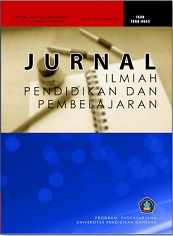EVALUASI PROGRAM PENILAIAN PENCAPAIAN KOMPETENSI I (PPK I) DENGAN MODEL CONTENT, INPUT, PROSES, DAN PRODUCT (CIPP)
DOI:
https://doi.org/10.23887/jipp.v2i3.16228Abstract
The purpose of this study was to evaluate the PPK I program in order to identify its effectiveness. The method used in this study was the Context, Input, Process, and Product (CIPP) model of Stufflebeam. This research was conducted in the Midwifery 3 diploma program. Research subjects included 13 lecturers, and 2 education staff. Data collection was done by filling out questionnaires by the subject, as well as filling out the interview sheet. The data obtained were analyzed by percentile quantitative analysis. The results showed that: 1) 78.21% of the Context dimension supported the PPK I program, 2) 74.8%, the Input dimension supported the PPK I program, 3) 82%, of the Process dimension supported PPK I and 4 programs) 78%. Product dimensions support the PPK program I. From the results of the above research, it can be concluded that the Context dimension of the category of effectiveness is sufficient, the dimensions of the input category of effectiveness are sufficient, the dimensions of the Process category are high, and the dimensions of the category of effectiveness are sufficient. Keywords: Evaluation, CIPP, PPK IReferences
Arikunto S dan Saffrudin, Cepi. 2004. Evaluasi Program Pendidikan Pedoman Teoritis Praktis Bagi Praktisi Pendidikan. Jakarta: Bumi Aksara.
Ashiong,P. Munthe. 2015. Pentingya Evaluasi Program Di Institusi Pendidikan: Sebuah Pengantar, Pengertian, Tujuan dan Manfaat. Scholaria, Vol. 5, No. 2, Mei 2015: 1 - 14.
Dwi Muryadi, Agustanico. 2017. Model Evaluasi Program dalam Penelitian Evaluasi. Jurnal Ilmiah PENJAS, Vol.3, No.1.
Farida Yusuf Tayibnapis. (2008). Evaluasi Program dan Instrumen Evaluasi. Jakarta: Rineka Cipta.
Jeane, Marie Tulung. 2014. Evaluasi Program Pendidikan Dan Pelatihan Kepemimpinan Tingkat IV di Balai Diklat Keagamaan Manado. Journal “Acta Diurna” Volume III. No.3
John Mayne & Ray C. Rist. (2006). ”Studies are Not Enough: The Necessary Transformation of Evaluation”. The Canadian Journal of Program Evaluation. Vol. 21 No. 3.
Kementerian Kesehatan Republik Indonesia.2012. Pedoman Penilaian Pencapaian Kompetensi Program Pendidikan Diploma III Kebidanan. Jakarta: Badan Pengembangan dan Pemberdayaan SDM Kesehatan Pusat Pendidikan dan Pelatihan Tenaga Kesehatan.
Koyan, Wayan. (2007). Statistika Terapan (Teknik Analisa Data Kuantitatif). Singaraja : Universitas Pendidikan Ganesha.
Muyasaroh, Sutrisno. 2014. Pengembangan Instrumen Evaluasi Cipp Pada Program Pembelajaran Tahfiz Al-Qur’an Di Pondok Pesantren. Jurnal Penelitian dan Evaluasi Pendidikan Tahun 18, Nomor 2.
Pusat Pendidikan Tenaga Kesehatan, 2004. Panduan Pembelajaran Klinik Pendidikan Diploma III Kesehatan. Jakarta.
Pusat Pendidikan dan Pelatihan Tenaga Kesehatan,2011. Pedoman Penyusunan Kurikulum. Jakarta.
Scheirer, M.A. (2000). ”Getting More “Bang” for Your Performance Measures “Buck”. American Journal of Evaluation. Vol. 21(2), 139–149.
Young, G. (2006). ”Evaluation Can Cross the Boundaries: The Case of Transport Canada”. Canadian Journal of Program Evaluation. Vol. 21(3), 73–92.
Downloads
Published
How to Cite
Issue
Section
License
Authors who publish with the Jurnal Ilmiah Pendidikan dan Pembelajaran (JIPP) agree to the following terms:
- Authors retain copyright and grant the journal the right of first publication with the work simultaneously licensed under a Creative Commons Attribution License (CC BY-SA 4.0) that allows others to share the work with an acknowledgment of the work's authorship and initial publication in this journal.
- Authors are able to enter into separate, additional contractual arrangements for the non-exclusive distribution of the journal's published version of the work (e.g., post it to an institutional repository or publish it in a book), with an acknowledgment of its initial publication in this journal.
- Authors are permitted and encouraged to post their work online (e.g., in institutional repositories or on their website) prior to and during the submission process, as it can lead to productive exchanges, as well as earlier and greater citation of published work. (See The Effect of Open Access)









